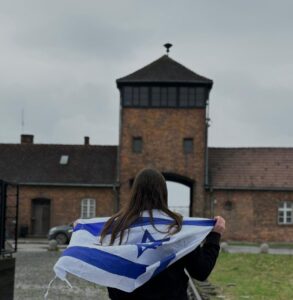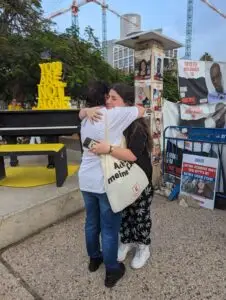By: Sergio Edelstein
Some years ago, being already a graduate from the Tnua [Movement], I read an article titled “The Ideological Development of Hanoar Hatzioni”, written by the then Mazkir
[Secretary] of the world movement, Yehuda Talmi z¨l.
The said article provides an interesting historical overview of the development, since inception, of Hanoar Hatzioni’s ideological and educational path. The overview shows
three main eras of the said development:
? The first era, the romantic scout period.
? The second era, the period of restlessness and search for the crystallization of the
worldview.
? The third era, the period of realization and confrontation, an inevitable result of the
need to put to the test the truth of our ideological road.
In the following lines, I will make a daring but respectful attempt to continue writing
general guidelines for Hanoar Hatzioni’s fourth, contemporary era.
First of all, I will summarize the central topics of the aforementioned article so that they
may guide me during the presentation. Yehuda Talmi starts by raising questions that, in
my opinion, are central and relevant:
? Is there a special experience, a specific youth culture?
? Was the youth movement created in order to provoke changes in society, culture,
and lifestyle?
? What are the characteristics of Hanoar Hatzioni throughout its years of activity?
Yehuda makes a brief summary of the said characteristics of Hanoar Hatzioni: “It is a youth movement par excellence; it has a tendency towards Scouting as a shaping educational system; it offers clear views on life and the world; it rejects extremism in its entire scope; it provides the chaver [member] with personal realization as the foundation of his personal example”.
The journey through the different stations of Hanoar Hatzioni’s fascinating educational and ideological development is simply brilliant. And every stage or era “has its own justification, the ideas and ideology that influenced its development and the educational
principles on which such development is based”.
I will endeavor to face these same parameters in the fourth station.
The fourth era: Pragmatic Consolidation
Justification
The last years of the 20th century and the beginnings of the 21st century have several
identifiable characteristics and trends (we cannot mention them all within this
framework), some of which are the following:
? The academically named “post-modernism”, which develops as an idea, especially
in the social sciences and humanities.
? The accelerated rhythm of technological development, especially in the field of
telecommunications and science (the decoding of the DNA with all its present and
future implications).
? Globalization, which on the one hand compressed the world into a “small town”,
and on the other, emphasized social differences in an alarming manner.
? The possibility of young people communicating among themselves from anywhere
in the world, in a fluent, comfortable, and above all, available and cheap manner, is
a key point in the processes we will see below, and all of it in only twenty years.
From two decades of social opening, be it with the rupture of sexual taboo or innocence,
the struggle for student rights or against wars that were not seen as making any sense
(perhaps following the atrocities of the world wars), young people entered into sexual
caution caused by the fear of AIDS. All this was somehow added to the rupture of the
existing dreams or the beginning of new dreams, with the fall of the old Soviet Union,
constant changes among socialist governments or those with capitalist tones in the West,
together with religious fundamentalism in other regions.
In Israel, reality changes with dizzying speed. The radical change of the traditionally
accepted concept of the “need to get out and fight only when facing a life threat” for a
concept that maintains that a war may alter political realities. This change confronts the
vision that achieving Peace is not a “far away dream” but a “reality”.
Awarenes consolidates around the fact that we cannot dominate another people and pretend to maintain moral values whose elements we consider to be honest. The enormously quick
increase in population, with the arrival of over a million new immigrants. The widening of social gaps generated by ultra-liberal policies, imported from foreign trends, that lead to the end of the traditional welfare state or, at least, of the state’s interest in the poor,
ensured by the assumption that the Jewish state cannot allow people to hunger. Lastly, the end of the anomalous situation prevailing until the end of the eighties, in which there
were Jews who could not “make aliyah” due to political problems: as of the beginning of the nineties, every Jew that decides to do so can live in Israel and become a citizen, if he
or she so desires.
This overview allows us to focus on this fourth era, on the basis of the reality
accompanying these years and that undoubtedly influences Hanoar Hatzioni’s current
“Pragmatic Consolidation”.
Influencing Ideas, Ideals, and Ideology
Following a chronological-historical line, we can see that in two decades there have been
enormous changes in the ideology concerning realization, which Hanoar Hatzioni
considered as central and as a true reflection of its educational values.
This ideology signified the highest aspiration of the ideal that reflected the worldview
developed in the previous eras. And precisely the successful confrontation with those
changes demonstrates Hanoar Hatzioni’s solid foundations: its Pragmatic Consolidation,
based on values worth teaching and practicing, as well as flexibility of thought, making it
possible to adopt the ideology so that it represents the essential values and not vice-versa.
From my standpoint, the facts that had a critical influence on ideological adaptation
without this causing the loss of our values are as follows:
? The formation of the “Tnua Kibutzit Meujedet” (Takam – United Kibbutz Movement)
which the Hanoar Hatzioni Kibbutzim join as an integral part, with a measure of
ideological autonomy;
? The economic and social crisis that starts affecting the kibbutzim as a result of Israel’s
great economic crisis (since 1983) and which is delayed until the beginning of the
‘90s;
? The ideological bankruptcy regarding the distribution of goods and services in the
Kibbutz.
The repercussions of these three events are not random in the eyes of the researchers or
of the Kibbutzim’s own chaverim, nor are they unnoticed by the bogrim
[graduates/adults] of the Tnua throughout the world, who for years saw the Kibbutz as
the highest identification of their ideals, as a potential optional mode of life, of personal
realization, and an authentic form of fulfilling the legacy of the Shichvat Magshimim
[Implementers’ Stratum]. The Kibbutz is not seen as an impalpable shape, but rather as a
real and active mode of insertion into the Israeli society in general and a form of ordered
and organized absorption, even when there is no personal ideological support. However,
it is in these years that many kibbutzim ask themselves existential questions, and the issue
of absorption of new chaverim, whether they come from Hanoar Hatzioni or from other
human sources, is not only outside its priorities, but in most of the cases, the absorption
of new members (aside from those born within the framework of the Kibbutz) is not
allowed or is postponed towards an uncertain future.
This message reaches also the bogrim of the Tnuá, who are in the midst of critical stages
regarding their personal life choices. Bogrim who participate in Shnat Hachshara
[Training Year] programs, drench themselves in the subject of making contact with the
Kibbutz’s own chaverim (adoptive families, work colleagues, and young people like
them). Its repercussion on the discussions, thoughts, and educational programs of the
keinim [nests] starts being inevitable.
The Veida Olamit [World Assembly] of 1996 conferred educational validity to the
prevailing currents when a decision was made (and later endorsed by the Mazkirut
Olamit [World Secretariat]) about re-writing “Darkeinu” [“Our Way”] (the previous
edition was from 1963). The chapter on the “Kibbutz” was written anew and its new title
was “Hagshama” [“Realization”], with all the significance and contents that this concept
shows, reflecting the reality in Israel and of our bogrim in the Jewish world: the true need
to offer a real and current sense to the value of “Personal Realization” that has flown
from our sources for seventy years.
The Mazkirut Olamit attempts to take the place of the Kibbutz as first absorption
framework, undertaking a leading role, giving a different meaning to the “Bama”
framework – which already existed –, focusing it on the assistance granted to the olim
chadashim [new immigrants] in their decision process towards future aliyah and the first
steps in Israel.
The change generated at the Veida did not result in leaving aside the constituent values of
the Movement’s Worldview; on the contrary, it reinforced them on the basis of the
surrounding reality (Hanoar Hatzioni’s last Garin Alia [Aliyah Nucleus] arrived in Israel
in 1985), in which the bogrim make Aliyah, seeing the imperious need to train
themselves or serve in Tzahal [Israeli Army] as the first steps of their absorption in Israel
and as the beginning of their participation in the life of a developed country, with ample
fields of possibilities for self-development, participation, activity… The significance is
that of being part of the Israeli society in general, of living a natural Jewish life. It is thus
that hundreds of bogrim fulfill the legacy of the Tnua and make Aliyah, being absorbed
into the range of possibilities that Israeli society offers and participating actively in the
Mazkirut Olamit as part of the educational team, thus giving a true personal example to
our chanichim [undergraduate members].
In summary, the ideological change taking place in Hanoar Hatzioni is a product of the
great changes experienced by the Kibbutz in particular and Israeli society in general,
which give a different, current and live meaning to the value of “Personal Realization”; a
concept and value that stays alive and real in Hanoar Hatzioni’s current educational
ideals. The plurality of possibilities for personal realization changed the meaning of the
educational target of the Tnua.
Educational Principless
Hanoar Hatzioni’s educational principles are intrinsically related to the diagnosis of the
period in general, of young people, and of changing ideologies. It is precisely in this
fourth era that the Tnua focuses its educational activity on principles of formal education
par excellence, education with basic features that define it and provide it with its special
significance for the education of future generations of Jewish and Zionist youngsters.
The educational principles guiding our educational work, deriving from our Jewish,
Zionist, humanist, and liberal vision, are implicitly and explicitly reflected in the
formation of the bogrim of Hanoar Hatzioni.
These principles are implemented in the following:
? Educational processes with commitment, conviction, and coherence;
? Clarity of the Zionist message of realization, which considers Israel to be the
sovereign place in which every Jew may live as such;
? Intense Zionist community activity
? Chronological extension of the educational process beyond the period of activity in
the Tnua proper;
? Promotion of the Israeli experience and the use of Israel as methodological
framework and, above all, as educational source.
All this is guaranteed by a dialogue, mutual help and respect between the educator and
the recipient of education, active participation in the decision-making process, and by
critical thinking about the humanist formation of the boguer.
These characteristics and principles are based on several fundamental premises, as
follows:
? Democracy in decision-making and educational processes;
? Educational planning made by the participants in the educational transaction
themselves;
? Strengthening of the justified youth experiences by a delay structure;
? Implementation of complex educational projects that exercise educational manhigut
[leadership] and commit the boguer with a coherent ideological message.
Talmi mentions that, since inception, “Hanoar Hatzioní appeared before the Jewish people
first of all as a youth movement par excellence”, an assertion that is undoubtedly relevant,
current, and correct in this fourth era.
The leading role in the formation of Jewish youth turns into a special path with the
radical change in the place of the Jewish school in Zionist education and, above all, the
change in formal systems. The Tnua, as a non-formal educational medium, with
characteristics beyond attempts by the school of “employing non-formal techniques”, is
an alternative to that which surrounds the Jewish youth, superficial and individualistic
frames that have a doctrine of consumption based on ambition as a measure of success.
This leading place in Jewish-Zionist education is emphasized in the Zionist contents that
Hanoar Hatzioni transmits as legacy. Even when the Israeli reality, the world Jewish
reality, or simply, the world, reality, clouds this Zionist message, this Zionist torch is
carried proudly by the bogrim. Bogrim whom the surrounding world and local realities
provoke into posing questions, doubting, training themselves, thinking, and not always
implement the message of realization. In spite of this, the education that the young
person receives in the Tnua provides him/her with a formation that lasts the whole life,
gives it content and meaning. The rapprochement to action, to commitment, and to belonging to the Jewish people of which he/she is an integral part (and thus we avoid the
assimilation of our brethren) and the clarification (hasbarah) regarding Israel, are both symbols that make our bogrim into thinking persons, committed, critical, pluralist, democratic, and adventurous in the challenge to be part of the millenary legacy of the
Jewish people and in our time, its reflection in the Zionist dream, materialized in the
State of Israel.
Following the above, we can return to the main questions in Talmi’s article:
? Is there a special experience, a specific youth culture?
? Was the youth movement created in order to provoke changes in society, culture,
and lifestyle?
In my opinion, this fourth era in the life of Hanoar Hatzioni provides positive answers to
these questions: Hanoar Hatzioni’s educational framework offers in these current times a
specific and special youth experience, which has the elements and ideals necessary for
participating in building a new, better, and more just society, the creation of a creative
Jewish culture, and leading a full and normal Jewish lifestyle. The boguer of the Tnua
participates most actively both in his/her own educational process as well as in that of
his/her chanichim, with constant intensity and ideological depth. A process that shapes
him/her, allows him/her to grow in a healthy alternative framework, with contents worth
teaching and through a creative, critical method that includes state-of-the-art educational
elements.










